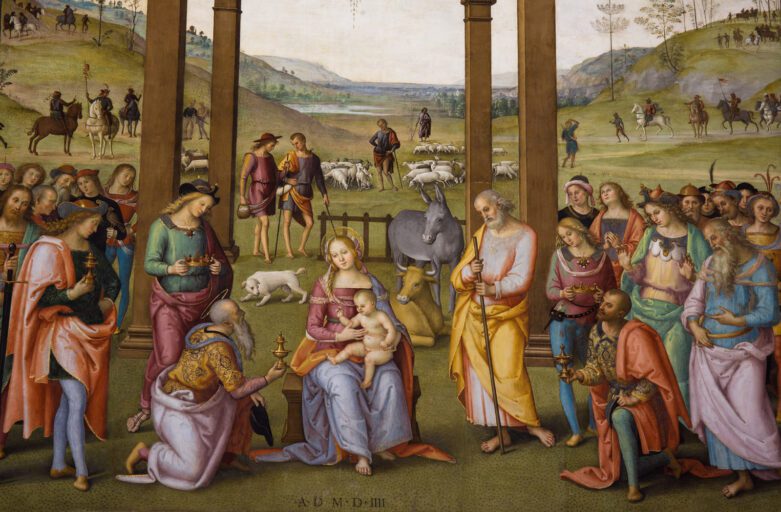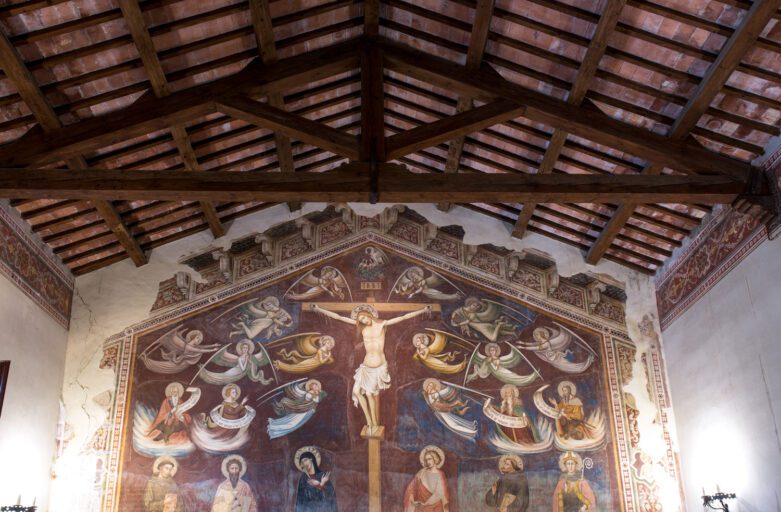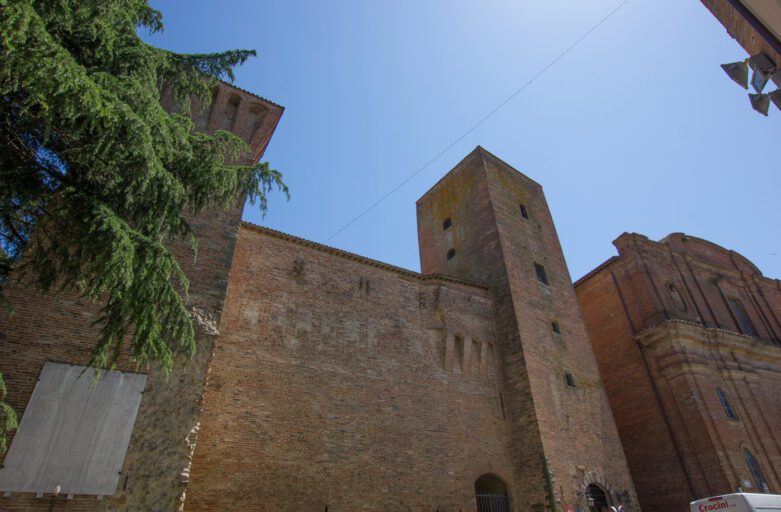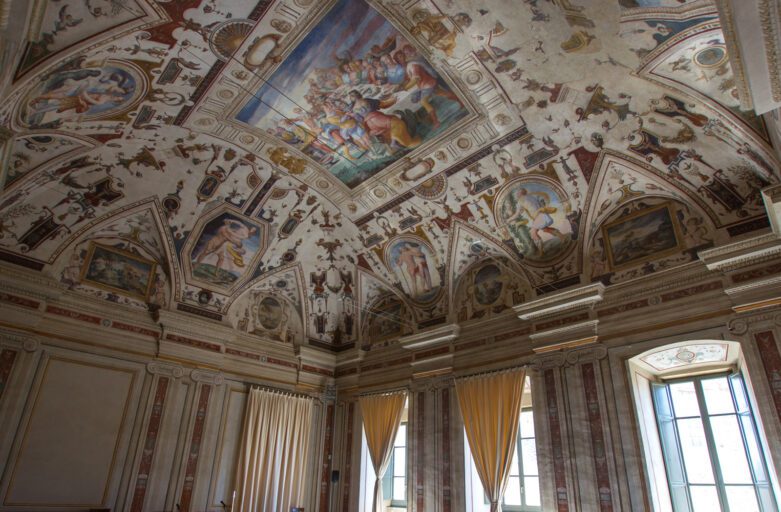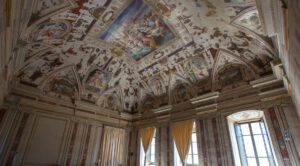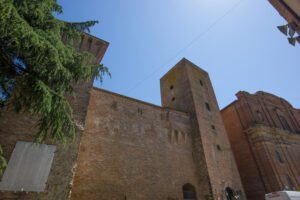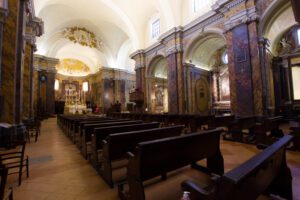The Church of the White-clad Brotherhood
The Oratory (smaller church) and Church of Santa Maria dei Bianchi, “Holy Mary of the [Brotherhood in] White,” are in downtown Città della Pieve. You may reach this monument by following a fascinating street, Via Pietro Vannucci, that runs from the Della Corgna Palace to a gate called Porta Sant'Agostino or Porta Fiorentina, the northern entry to the town.
Ancient documents show that a building existed here as early as the 13th century. It was chosen as the seat of the Confraternita dei Disciplinati, “Brotherhood of the Disciplined,” that is, people doing penance; or precisely dei Bianchi, “of the White,” with reference to their tunics. The church was in connection with a hospital, that would later be used as a poorhouse. Such places could be created thanks to the many donations Medieval brotherhoods received, so as to becoming important social hubs for the poorest sick people and for pilgrims. We can still nowadays see, inside the church, the holes where the alms had to be put.
The building was renewed in the 18th and 19th centuries, under the influences of Rococo and then Neoclassicism. The outside exhibits elements from Greek/Latin architecture, employed discreetly, in a refined arrangement. A cornice jutting out divides the façade horizontally, making two main areas. In the middle, the gate is surmounted by a tympanum. Empty recesses appear on both sides. On the upper level the space is marked by a square window, surmounted by a small elliptical opening. Moreover, the façade is vertically divided in three parts by fake pillars, whose function is to give the structure a vertical push. The façade is perfectly inset in the ubiquitous architectural style of the town, where bricks play a role as protagonists.
The interior
The church is internally structured as a vast rectangular room with cross vaults. The side walls are given a rhythm by elegant paraste (recessed pillars) whose elements come from different architectural styles, while the color white creates a light, graceful atmosphere. The visitors' attention is immediately caught by a magnificent fresco on the far wall: The Adoration of the Magi painted by Pietro “Perugino” Vannucci in 1504.
On both sides of the altar, two narrow passages lead to the adjoining church. This was built in the 17th century when they needed a bigger space for an increasing number of faithful. The church has one nave and a quadrangular apse; on the side walls, wide recesses house altars. It is a type of architecture clearly dating back to the 18th century, in line with the aesthetic/cultural patterns in the oratory.
Perugino and the Oratory
In 1835, during drainage works at the frescoed wall, two letters written by Perugino were discovered. They were reproduced on marble plaques, and set on the side walls of the Oratory of the White. The letters confirm that Perugino had been commissioned in 1504 for the Adoration of the Magi, and moreover, leak some lively details about the making of the great fresco.
In February 1504, negotiations began between Pietro Vannucci and the White-clad Brotherhood. At first, the painter requested 200 Fiorins for the job. But he was soon forced to lower the sum and be happy with 100 Fiorins, that would be given him in installments in three years. It was still not over: since the auditor of the “Company of the Disciplined” insisted, Perugino would further reduce the payment to 75 Fiorins.
Here are the painter's words, originally in a quite ungrammatical Italian: “My dear Sir, the painting you mean to have made in the Oratory of the Disciplined – two hundred Fiorins would be needed, at least. I will settle for one hundred as a fellow countryman, and [namely] twenty-five immediately, the others in three years, twenty-five yearly, and if this contract sounds good, please send me the paper and the money, and we are agreed. – [Signed by] me, Pietro the painter, by my own hand, Perugia, February 20, 1504.”
Finally, Perugino had an unusual request: he needed some means of transport, Perugia - Città della Pieve and back. He was given a mule.
The Adoration of the Magi
The Adoration of the Magi in Città della Pieve is among the most complex works by Perugino. The idyllic landscape, in delicate colors, recalls the green contours of Nature in Umbria; while many characters, in gentle attitudes, crowd the scene. The composition is solemn, the color choice refined. Set in the central area of the fresco are Virgin Mary with the Infant Jesus, to whom the three Wise Men bring their gifts. The main characters are framed within an elementary architectural structure with classical-like elements. Mary, sitting, hugs her Child with love; he looks to our left, toward the old Wise Man. Their graceful features convey purity, humbleness, with a touch of melancholy sweetness
A Comparison with Other Works by Perugino
A clear difference can be noticed vis-a-vis the Adoration of the Magi Perugino had painted some thirty years before (1475), now at the Galleria Nazionale dell'Umbria (National Art Gallery in Umbria, Perugia). In this latter case, the characters were set in the foreground, and the colors were darker, with contours harder to distinguish. The landscape, influenced by Leonardo Da Vinci, was limited to a small area in the background.
More analogies can be seen, instead, between the Adoration at the Oratory of the White and Perugino's fresco of 1482, Moses Leaving for Egypt, in the Sistine Chapel in Rome. Here, again, appear a sweet hill landscape, a bucolic atmosphere created by sheep and a group of shepherds, and some exotic animals, among which a dromedary.
INFO
Location
Via Pietro Vannucci, 37/39, 06062 Città della Pieve PG
Contacts
info@secretumbria.it
